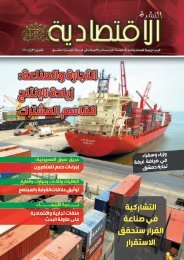SIGAR
2017-01-30qr
2017-01-30qr
You also want an ePaper? Increase the reach of your titles
YUMPU automatically turns print PDFs into web optimized ePapers that Google loves.
COUNTERNARCOTICS<br />
remained the top opium-cultivating province, followed by Badghis,<br />
Kandahar, Uruzgan, and Nangarhar. 840 The verification process for several<br />
years has included comparing satellite imagery against data provided on<br />
the ground.<br />
For 2016, UNODC reports that most provinces claimed results greater<br />
than the amount of eradicated fields on the ground. Moreover, the majority<br />
of fields were poorly eradicated. In Badakhshan Province (where overreporting<br />
was confirmed and the final eradication figure corrected), satellite<br />
imagery confirmed that 78% of the fields were less than 20% eradicated, followed<br />
by 13% percent of the fields that were less than 30% eradicated. Only<br />
20 fields were more than 80% eradicated. 841<br />
Eradication results for 2016 were the lowest reported in the past decade,<br />
and when compared with cultivation and production totals in Table 3.31 on<br />
page 188, they illustrate current levels of eradication have not succeeded<br />
in discouraging farmers from growing the crop. 842 UNODC reports that<br />
eradication needs to be adequately complemented by programs that provide<br />
alternative livelihoods. 843<br />
Good Performers Initiative<br />
INL suspended the $143 million Good Performers Initiative (GPI) last year<br />
due to the MCN’s inability to implement the program properly. GPI was a<br />
program implemented by the MCN that sought to incentivize provincial<br />
counternarcotics performance. No new GPI projects have been approved<br />
since April 30, 2016, but funding will continue until current projects<br />
are completed.<br />
INL and UNODC negotiated two new alternative-development programs that<br />
launched in October to supplement activities performed under GPI. Moreover,<br />
INL is independently developing a post-GPI alternative-development, food-zone<br />
based program. 844 The letters of agreement for these programs were signed in<br />
August and September 2016. 845<br />
As of October 31, 2016, there have been 286 GPI projects worth<br />
$126.2 million: 214 projects have been completed; 69 projects are ongoing<br />
including three near completion. 846<br />
ALTERNATIVE DEVELOPMENT/ALTERNATIVE LIVELIHOOD<br />
USAID’s alternative-development (AD) programs are intended to support<br />
U.S. counternarcotics objectives by helping countries develop economic<br />
alternatives to narcotics production. INL funding supports supply-reduction<br />
and AD programs. INL told <strong>SIGAR</strong> it coordinates regularly with USAID to<br />
ensure that INL-supported AD efforts complement past and ongoing investments<br />
by USAID in licit livelihoods and rural development in Afghanistan. 847<br />
INL AD programs align with the AD objectives of the U.S. government’s<br />
counternarcotics strategy, in support of Afghanistan’s NDAP goals. INL AD<br />
A food-zone based program: is designed<br />
to transition an area dependent on opium<br />
agriculture to a licit agricultural economy.<br />
Poppy-free zones are created throughout<br />
the program’s duration. The program<br />
strategy involves a public information<br />
campaign, alternative livelihood inputs,<br />
law enforcement, and a drug demand<br />
reduction program. It is based on the<br />
Helmand Food Zone program which ran<br />
with assistance from the British and<br />
Danish governments from 2008 to 2012.<br />
Source: USAID website, “Hilmand Food Zone Project (HFZP)<br />
Factsheet,” www.usaid.gov/node/51021 accessed 1/5/2017;<br />
Ministry of Counter Narcotics website, Food Zone, http://mcn.<br />
gov.af/en/page/5138/5141 accessed 1/7/2017; Victoria<br />
A. Greenfield, Keith Crane, et al., Reducing the Cultivation of<br />
Opium Poppies in Southern Afghanistan, 6/2015, pp. 181–<br />
182; <strong>SIGAR</strong>, Quarterly Report to the United States Congress,<br />
10/30/2015, p. 119.<br />
REPORT TO THE UNITED STATES CONGRESS I JANUARY 30, 2017<br />
193







